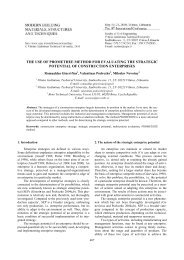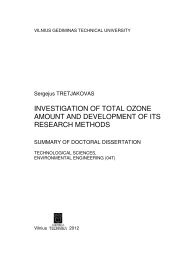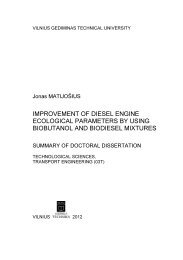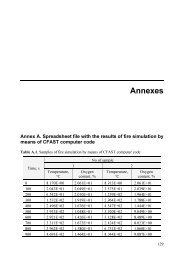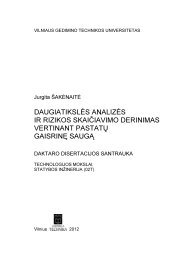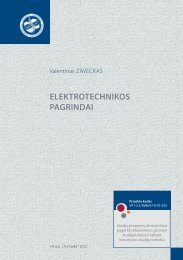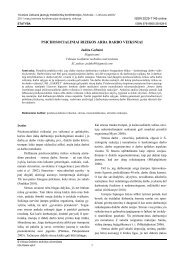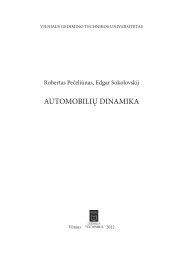investigation of locomotive electrodynamic braking - Vilniaus ...
investigation of locomotive electrodynamic braking - Vilniaus ...
investigation of locomotive electrodynamic braking - Vilniaus ...
Create successful ePaper yourself
Turn your PDF publications into a flip-book with our unique Google optimized e-Paper software.
VILNIAUS GEDIMINO TECHNIKOS UNIVERSITETASLionginas LIUDVINAVIČIUSINVESTIGATION OF LOCOMOTIVEELECTRODYNAMIC BRAKINGSUMMARY OF DOCTORAL DISSERTATIONTECHNOLOGICAL SCIENCES,TRANSPORT ENGINEERING (03T)Vilnius 2012
Doctoral dissertation was prepared at Vilnius Gediminas Technical Universityin 2008–2012.Scientific SupervisorPr<strong>of</strong> Dr Habil Leonas Povilas LINGAITIS (Vilnius Gediminas TechnicalUniversity, Technological Sciences, Transport Engineering – 03T).The dissertation is being defended at the Council <strong>of</strong> Scientific Field <strong>of</strong>Transport Engineering at Vilnius Gediminas Technical University:ChairmanPr<strong>of</strong> Dr Habil Marijonas BOGDEVIČIUS (Vilnius Gediminas TechnicalUniversity, Technological Sciences, Transport Engineering – 03T).Members:Pr<strong>of</strong> Dr Žilvinas BAZARAS (Kaunas University <strong>of</strong> Technology, TechnologicalSciences, Transport Engineering – 03T),Pr<strong>of</strong> Dr Habil Roma RINKEVIČIENĖ (Vilnius Gediminas TechnicalUniversity, Technological Sciences, Electrical and Electronic Engineering– 01T),Assoc Pr<strong>of</strong> Dr Stasys SLAVINSKAS (Aleksandras Stulginskis University,Technological Sciences, Transport Engineering – 03T),Pr<strong>of</strong> Dr Habil Bronislovas SPRUOGIS (Vilnius Gediminas TechnicalUniversity, Technological Sciences, Transport Engineering – 03T).Opponents:Assoc Pr<strong>of</strong> Dr Algirdas JANULEVIČIUS (Aleksandras StulginskisUniversity, Technological Sciences, Transport Engineering – 03T),Pr<strong>of</strong> Dr Habil Algimantas Juozas POŠKA (Vilnius Gediminas TechnicalUniversity, Technological Sciences, Electrical and Electronic Engineering– 01T).The dissertation will be defended at the public meeting <strong>of</strong> the Council <strong>of</strong> ScientificField <strong>of</strong> Transport Engineering in the Senate Hall <strong>of</strong> Vilnius GediminasTechnical University at 9 a.m. on 11 January 2013.Address: Saulėtekio al. 11, LT-10223 Vilnius, Lithuania.Tel.: +370 5 274 4952, +370 5 274 4956; fax +370 5 270 0112;e-mail: doktor@vgtu.ltThe summary <strong>of</strong> the doctoral dissertation was distributed on 10 December2012.A copy <strong>of</strong> the doctoral dissertation is available for review at the Library <strong>of</strong> VilniusGediminas Technical University (Saulėtekio al. 14, LT-10223 Vilnius,Lithuania).© Lionginas Liudvinavičius, 2012
VILNIAUS GEDIMINO TECHNIKOS UNIVERSITETASLionginas LIUDVINAVIČIUSLOKOMOTYVŲ ELEKTRODINAMINIOSTABDYMO EFEKTYVUMO TYRIMASDAKTARO DISERTACIJOS SANTRAUKATECHNOLOGIJOS MOKSLAI,TRANSPORTO INŽINERIJA (03T)Vilnius 2012
Disertacija rengta 2008–2012 metais <strong>Vilniaus</strong> Gedimino technikos universitete.Mokslinis vadovaspr<strong>of</strong>. habil. dr. Leonas Povilas LINGAITIS (<strong>Vilniaus</strong> Gediminotechnikos universitetas, technologijos mokslai, transporto inžinerija –03T).Disertacija ginama <strong>Vilniaus</strong> Gedimino technikos universitetoTransporto inžinerijos mokslo krypties taryboje:Pirmininkaspr<strong>of</strong>. habil. dr. Marijonas BOGDEVIČIUS (<strong>Vilniaus</strong> Gedimino technikosuniversitetas, technologijos mokslai, transporto inžinerija – 03T).Nariai:pr<strong>of</strong>. dr. Žilvinas BAZARAS (Kauno technologijos universitetas,technologijos mokslai, transporto inžinerija – 03T),pr<strong>of</strong>. habil. dr. Roma RINKEVIČIENĖ (<strong>Vilniaus</strong> Gedimino technikosuniversitetas, technologijos mokslai, elektros ir elektronikosinžinerija – 01T),doc. dr. Stasys SLAVINSKAS (Aleksandro Stulginskio universitetas,technologijos mokslai, transporto inžinerija – 03T),pr<strong>of</strong>. habil. dr. Bronislovas SPRUOGIS (<strong>Vilniaus</strong> Gedimino technikosuniversitetas, technologijos mokslai, transporto inžinerija – 03T).Oponentai:doc. dr. Algirdas JANULEVIČIUS (Aleksandro Stulginskio universitetas,technologijos mokslai, transporto inžinerija – 03T),pr<strong>of</strong>. habil. dr. Algimantas Juozas POŠKA (<strong>Vilniaus</strong> Gediminotechnikos universitetas, technologijos mokslai, elektros ir elektronikosinžinerija – 01T).Disertacija bus ginama viešame Transporto inžinerijos mokslo krypties tarybosposėdyje 2013 m. sausio 11 d. 9 val. <strong>Vilniaus</strong> Gedimino technikos universitetosenato posėdžių salėje.Adresas: Saulėtekio al. 11, LT-10223 Vilnius, Lietuva.Tel.: (8 5) 274 4952, (8 5) 274 4956; faksas (8 5) 270 0112;el. paštas doktor@vgtu.ltDisertacijos santrauka išsiuntinėta 2012 m. gruodžio 10 d.Disertaciją galima peržiūrėti <strong>Vilniaus</strong> Gedimino technikos universitetobibliotekoje (Saulėtekio al. 14, LT-10223 Vilnius, Lietuva).VGTU leidyklos „Technika“ 2051-M mokslo literatūros knyga.© Lionginas Liudvinavičius, 2012
IntroductionTopicality <strong>of</strong> the problem. A rapid social and economic development <strong>of</strong>the European Union countries, their technical progress, world trade globalisationtendencies <strong>of</strong> the world trade, generate a huge demand for high-qualitytransportation services. The countries <strong>of</strong> the Western Europe, being concernedabout safety, environment, sustainable use <strong>of</strong> the electrical energy and otherresources, use economic and legal measures to encourage and further developtransportation <strong>of</strong> passengers and loads by railways. The main instrument for thesolution <strong>of</strong> electrical energy and other resources saving is the <strong>locomotive</strong>s <strong>electrodynamic</strong>braiking system railway transport perfection. This doctoral thesis isdevoted for the solution <strong>of</strong> the above-mentioned situations.The research subject. The principles <strong>of</strong> control <strong>of</strong> <strong>electrodynamic</strong> <strong>braking</strong>energy flows for the <strong>locomotive</strong>s with DC/DC, AC/DC, DC/AC, AC/ACsystems.The main goal and objectives <strong>of</strong> the work. The main goal <strong>of</strong> the paper isto conduct theoretical and experimental <strong>investigation</strong> <strong>of</strong> energy control systemsin DC/DC, AC/DC, DC/AC, AC/AC <strong>locomotive</strong>s and catenary system andevaluate the level <strong>of</strong> effectiveness <strong>of</strong> their energy use, to substantiate expansion<strong>of</strong> the energy control range for regenerative <strong>braking</strong> <strong>of</strong> the electric powered<strong>locomotive</strong>s, electric trains, metro, tramways and a possibility <strong>of</strong> regenerative<strong>braking</strong> in diesel-electric <strong>locomotive</strong>s.In order to achieve the purpose <strong>of</strong> the research the following objectivesneed to be accomplished:1. To analyze world’s scientific publications investigating effectiveness <strong>of</strong><strong>electrodynamic</strong> <strong>braking</strong> systems in <strong>locomotive</strong>s. To analyze the problems<strong>of</strong> theoretical and practical application and methods <strong>of</strong> their solution.2. To investigate new energy control systems in DC/DC, AC/DC, DC/AC,AC/AC <strong>locomotive</strong>s and catenary systems.3. To investigate theoretical presumption and submit practical solutions forrealization <strong>of</strong> regenerative <strong>braking</strong> in diesel-electric <strong>locomotive</strong>s.4. To create the new model <strong>of</strong> energy control in <strong>electrodynamic</strong> <strong>braking</strong>systems <strong>of</strong> non-traditional electric powered train.5. To design non-traditional energy control systems in DC/DC, AC/DC,DC/AC, AC/AC <strong>locomotive</strong>s and catenary system and mathematicalmodel <strong>of</strong> effectiveness <strong>of</strong> their energy.Research methods – regressive analysis, mathematical modeling andglobal optimization methods are used in this thesis.5
Novelty <strong>of</strong> the workThe following results new to the sciences <strong>of</strong> transport and electricalengineering were obtained while preparing the doctoral thesis:1. Theoretical presumptions for realization <strong>of</strong> practical solutions for theuse <strong>of</strong> the entire kinetic energy <strong>of</strong> <strong>locomotive</strong>s during <strong>electrodynamic</strong><strong>braking</strong> were submitted.2. Mathematical relation and graphic curves <strong>of</strong> the use <strong>of</strong> regenerative<strong>braking</strong> energy were developed.3. Theoretical presumptions for realization <strong>of</strong> practical solutions for regenerative<strong>braking</strong> in diesel-electric <strong>locomotive</strong>s were submitted.4. The non-traditional energy control systems in DC/DC, AC/DC, DC/AC,AC/AC <strong>locomotive</strong>s and catenary systems will minimize consumption<strong>of</strong> electricity and fuel in <strong>locomotive</strong>s by 25–30%.5. The application <strong>of</strong> mathematical model enables the calculation nontraditionalelectric powered train <strong>electrodynamic</strong> <strong>braking</strong> system controlparameters <strong>of</strong> deviation distribution.Practical value <strong>of</strong> the work results. The results <strong>of</strong> this thesis provide anopportunity to realize the practical solutions <strong>of</strong> regenerative <strong>braking</strong> in dieselelectric<strong>locomotive</strong>s. The obtained results can enable the design <strong>of</strong> newgeneration <strong>locomotive</strong>s with DC/DC, AC/DC, DC/AC, AC/AC systems orperforming modernization <strong>of</strong> the existing ones by introducing energy savingsystems in them. To design non-traditional energy saving system in the catenarysystem. To minimize consumption <strong>of</strong> electricity and fuel in <strong>locomotive</strong>s by25–30%.Defended propositions1. Design <strong>of</strong> energy saving systems in non-traditional <strong>locomotive</strong>s consumption<strong>of</strong> electricity and fuel in <strong>locomotive</strong>s would reduce by25–30%.2. New regenerative <strong>braking</strong> energy control systems in the traction rollingstockcan be applied in <strong>locomotive</strong>s with DC/DC, AC/DC, DC/AC,AC/AC systems.3. A possibility <strong>of</strong> regenerative <strong>braking</strong> will be created in diesel-electric<strong>locomotive</strong>s and diesel electric powered trains.4. Application <strong>of</strong> mathematical model <strong>of</strong> the parameters <strong>of</strong> <strong>electrodynamic</strong><strong>braking</strong> energy control system in non-traditional electric powered train.Approval <strong>of</strong> the results <strong>of</strong> the work. 13 scientific articles have beenpublished on the topic <strong>of</strong> this Doctoral Thesis: five articles in scientificmagazines, included into the list <strong>of</strong> “Science Citation Index Expanded (Web <strong>of</strong>Science)”, one article in other magazines referred to in international data bases,6
four articles in reviewed scientific magazines in English, German or French, 3articles in reviewed materials <strong>of</strong> an international conference held in Lithuania.The results <strong>of</strong> the research conducted in the doctoral thesis were presentedat 4 international research conferences: the international conference held in2008 in Katowice (Poland); the international conference TRANSBALTICA2009, held in 2009 in Vilnius (Lithuania); the international conferenceTRANSBALTICA 2011 held in 2011 in Vilnius; the international conferenceheld in 2011 in Katowice.The scope <strong>of</strong> the research work. The doctoral thesis consist from: theintroduction, five major chapters and general conclusions, the list <strong>of</strong> literatureand reference sources, list <strong>of</strong> publications <strong>of</strong> the author relevant to the topic <strong>of</strong>this thesis, and an addendum.The total volume <strong>of</strong> this thesis is 154 pages without addendum; there are75 numbered formulas, 79 figures, and 21 tables used. 100 literature sourceshave been used for the doctoral thesis. Addendum is shows in the CD.1. Locomotives <strong>electrodynamic</strong> <strong>braking</strong> systems analysisIn the analysis is proposed and the results <strong>of</strong> research works, performedboth nationally, and on the international level, conducted on the topic <strong>of</strong>effectiveness <strong>of</strong> <strong>electrodynamic</strong> <strong>braking</strong> <strong>of</strong> <strong>locomotive</strong>s and hybrid cars. Thereview <strong>of</strong> scientific literature includes the theoretical and practical aspects <strong>of</strong><strong>locomotive</strong> <strong>electrodynamic</strong> <strong>braking</strong>. The investigated scientific papers weredevoted to examination <strong>of</strong> possibilities <strong>of</strong> use <strong>of</strong> the new energy controlelements – supercapacitors.2. Research <strong>of</strong> the existing situation <strong>of</strong> <strong>locomotive</strong>s <strong>electrodynamic</strong><strong>braking</strong> systems and related perspectivesTraction rolling stock <strong>of</strong> public limited company “Lietuvos geležinkeliai”is given in Fig. 1. The thesis analysis only such traction rolling stock, whereelectrical power is used. The Fig. 1 shows a number <strong>of</strong> <strong>locomotive</strong>s, drive typeand analysis <strong>of</strong> <strong>electrodynamic</strong> <strong>braking</strong> systems.The performed analysis showed that traction rolling stock fleet <strong>of</strong> publiclimited company consists <strong>of</strong>: 314 sections without <strong>electrodynamic</strong> <strong>braking</strong>systems – 84% and 59 sections with rheostat <strong>braking</strong> systems – 16%. The fleet<strong>of</strong> traction rolling stock consists <strong>of</strong> the <strong>locomotive</strong>s given in the table, whereelectrical gears are used. In total LG has 373 <strong>locomotive</strong>s, where the electricalpower are used. Only 16% <strong>of</strong> the rheostat systems have been mounted in<strong>locomotive</strong>s, where the train kinetic power becomes heat in <strong>braking</strong> resistors.Though LG operates 18 electrical <strong>locomotive</strong>s ER-9M and 4 AC/AC current7
system electrical trains EJ-575, no one uses recuperation <strong>braking</strong> system.Structural scheme <strong>of</strong> the traditional structure AC/AC current system electricaltraction <strong>locomotive</strong> recuperation <strong>braking</strong> and mechanical characteristics <strong>of</strong>asynchronous traction engine are given in Fig. 2.Fig. 1. LG characteristics <strong>of</strong> traction rolling-stock fleetFig. 2. Structural diagram for regenerative <strong>braking</strong> <strong>of</strong> AC/AC system electric traction<strong>locomotive</strong> and speed–torque characteristics <strong>of</strong> asynchronous traction motorThe mechanical characteristics set in quadrant II shows that: A ‒recuperation is absent in the range <strong>of</strong> speeds, because the voltage <strong>of</strong> theasynchronous traction engine operating on generator mode is lower than thecatenary voltage; B ‒ recuperation is present in the range <strong>of</strong> speeds, because thevoltage <strong>of</strong> the asynchronous traction engine operating on generator mode islarger than the catenary voltage.8
Structural diagram for regenerative <strong>braking</strong> <strong>of</strong> AC/AC system electrictraction <strong>locomotive</strong> and speed–torque characteristics <strong>of</strong> asynchronous tractionmotor shows regenerative <strong>braking</strong> diapason only ‒ B.3. Locomotives <strong>electrodynamic</strong> <strong>braking</strong> experimental researchMain goals <strong>of</strong> experimental researches is to perform practical experiments <strong>of</strong>the latest traction rolling stock EJ-575 and ER-20 CF <strong>electrodynamic</strong> <strong>braking</strong>systems, owned by public limited company Lietuvos Geležinkeliai, and <strong>electrodynamic</strong><strong>braking</strong> systems and define the kinetic energy management efficiency,economic and other indicators. In order to achieve the major goal, an algorithmfor the research <strong>of</strong> traction rolling stock EJ-575 and ER-20 CF electrical parametershave been developed, individual measurement diagrams have been developedto select analogous-discreet signal converters. Experimental researches havebeen carried out under actual conditions, i. e. all electric train EJ-575 dynamicparameters have been measured by personal computer using <strong>locomotive</strong> controlprograms <strong>of</strong> the companies Škoda Vagonka, Škoda Transportation and SiemensAG on the railway section N. Vilnia–Vilnius–Kaunas and Kaunas–Vilnius–N. Vilnia, <strong>locomotive</strong> ER-20 CF on the section Vaidotai–Radviliškis andRadviliškis–Vaidotai–Vaidotai. During the research experimental <strong>of</strong> <strong>locomotive</strong>ER-20 CF kinetic energy in the <strong>electrodynamic</strong> <strong>braking</strong> mode is transformedto heat in <strong>braking</strong> resistors.Experimental researches have been carried out under actual conditions,i. e. all electric train EJ-575 dynamic parameters have been measured by personalcomputer using <strong>locomotive</strong> control programs <strong>of</strong> the companies Škoda Vagonka,Škoda Transportation and Siemens AG on the railway section N. Vilnia–Vilnius–Kaunasand Kaunas–Vilnius–N. Vilnia, <strong>locomotive</strong> ER-20 CF onthe section Vaidotai–Radviliškis and Radviliškis–Vaidotai–Vaidotai.The values <strong>of</strong> double-deck electric train EJ-575 energy managementparameters for traction-<strong>electrodynamic</strong> <strong>braking</strong> mode have been measured by apersonal computer Fig. 4.The <strong>electrodynamic</strong> <strong>braking</strong> energy management efficiency <strong>of</strong> electrictrain EJ-575 is shown Fig. 5 by <strong>braking</strong> capacity P B (t) variation diagrams.These diagrams show that in <strong>braking</strong> cycles: The appropriate areas defined bycurves with the axis <strong>of</strong> abscissas describe the value <strong>of</strong> t 1 –t 2 , t 3 –t 4 <strong>electrodynamic</strong><strong>braking</strong> power P B (t) converting to heat in <strong>braking</strong> resistors. During theexperimental researches it was identified that kinetic energy electrical trainsEJ-575 during <strong>electrodynamic</strong> <strong>braking</strong> transformed to heat in <strong>braking</strong> resistors.9
Fig. 3. Diagram <strong>of</strong> research for EJ-575 electric train <strong>electrodynamic</strong> <strong>braking</strong>experimental parameters when PC is usedFig. 4. Values <strong>of</strong> parameters <strong>of</strong> power control for EJ-575 two-stored electric train intraction and <strong>electrodynamic</strong> <strong>braking</strong> modes10
The parameters <strong>of</strong> double-deck electric train EJ-575 have been calculatedin the <strong>electrodynamic</strong> <strong>braking</strong> cycles 1S and 2S and presented in Fig. 5.Fig. 5. Curves for omhic power used by EJ-575 two-stored electric train fromthe catenary system in traction and <strong>electrodynamic</strong> <strong>braking</strong> cycles:P T (t) – omhic power, kW; P B (t) – <strong>electrodynamic</strong> <strong>braking</strong> power, kW; t – time (s)During the experimental researches it was identified that kinetic energyduring <strong>electrodynamic</strong> <strong>braking</strong> transformed to heat in <strong>braking</strong> resistors relatedto train No. EJ 818 (22, 4%), train No. EJ 821 (36, 1%).4. Non-traditional structure <strong>locomotive</strong> kinetic energy control systemsNon-traditional structure AC/AC current system <strong>locomotive</strong> kinetic energycontrol scheme (on the left – electric traction <strong>locomotive</strong>s, on the right –<strong>locomotive</strong>s with electric power) is presented in Fig. 6.Fig. 6 presents universal AC/AC current system <strong>locomotive</strong> kinetic energymanagement system suitable to both electric traction <strong>locomotive</strong>s and diesel<strong>locomotive</strong>s. In order to expand the recuperation <strong>braking</strong> range in an electrictraction <strong>locomotive</strong>, to implement recuperation <strong>braking</strong> system in a diesel<strong>locomotive</strong>, it is necessary to connect energy storage batteries to intermediateDC circuit through to directions energy control keys. AC/AC current system<strong>locomotive</strong> non-traditional kinetic energy management structure providestheoretical and practical conditions to expand the recuperation <strong>braking</strong> range inelectric powered <strong>locomotive</strong>s until the full stopping, when the range <strong>of</strong> speedsB – energy is returned to catenary, A – (Fig. 7) accumulated in energy storagebatteries. AC/AC current system diesel-electric powered <strong>locomotive</strong> nontraditionalkinetic energy management structure provides theoretical andpractical conditions to implement the recuperation <strong>braking</strong> system, because11
energy return circuit is formed. Such a circuit does not exist in traditionalstructure diesel <strong>locomotive</strong>s.Fig. 6. Structural diagram <strong>of</strong> kinetic energy control for non-traditional structure AC/ACsystem <strong>locomotive</strong>s: on the left – electric traction <strong>locomotive</strong>s,on the right – diesel-electric <strong>locomotive</strong>: Y1, Y2 – control signalsThe author in the article (L. Liudvinavičius et al. 2010) <strong>of</strong>fers to make amanagement system for non-traditional AC/AC current system diesel – electricpowered <strong>locomotive</strong> <strong>electrodynamic</strong> <strong>braking</strong> energy flows as circuit diagram andasynchronous traction motor speed-torque characteristics presented in Fig. 7.Fig. 7. Non-traditional <strong>of</strong> AC/AC current system diesel-electric powered <strong>locomotive</strong><strong>electrodynamic</strong> <strong>braking</strong> energy flow management circuit diagram and asynchronoustraction motor speed-torque characteristics12
Non-traditional structure diesel-electric powered <strong>locomotive</strong>, recuperation<strong>braking</strong> energy will be used in B and A speed range. In a range <strong>of</strong> speeds ‒ Bduring recuperation <strong>braking</strong> energy will be returned to energy storage battery.5. Electric train kinetic energy control systems formation and use<strong>of</strong> mathematical modelAC/AC current system non-traditional structure electric train energycontrol parameters. Economical usage, consumption from grid and accumulatedin power energy storage batteries, stability <strong>of</strong> energy system-tractiontransformer parameters, <strong>locomotive</strong> operation life and other parameters dependupon the automatic management system (AMS). Instability <strong>of</strong> characteristicsand their possible deviations from nominal values may be fully characterizedby parameter reliability. Calculated AC/AC current system non-traditionalstructure electric traction energy management traction, <strong>electrodynamic</strong> <strong>braking</strong>(largest) parameter reliability P 0.The most important parameters <strong>of</strong> empirical distributions are regarded theaverage (average feature value in a sample) and dispersion (or – average squaredeviation). Non-traditional structure electric train energy management<strong>electrodynamic</strong> <strong>braking</strong> system presented in graphs is given in Fig. 8.It is possible to describe electromechanical systems in a mathematic modelby using a theory <strong>of</strong> graphs, whose basis is objective measurement <strong>of</strong> physicalparameters. By analyzing the results <strong>of</strong> the measured and calculated nontraditionalelectric train energy and its computer management system it ispossible to assess their value <strong>of</strong> parametric reliability P 0 in potential(maximum). A theory <strong>of</strong> graphs is used to assess the value <strong>of</strong> parametricreliability P 0 .A rule <strong>of</strong> three sigma: if an accidental value X has been distributed as pernormal law, then it is possible value form the average digresses no further thanwithin 3 standard deviations (through 3 sigmas).Three sigma methods is used for the determination <strong>of</strong> the maximumAC/AC non-traditional current system <strong>locomotive</strong> (electrical train) measuredvalue ( I Tr , U Tr , U d , P B , I b, P Σ ) deviations from the arithmetical average with theessence is that the maximum deviations <strong>of</strong> accidental values do not exceed –3σ. Based on the theory <strong>of</strong> graphs, in a common case it is possible to write anequation, if one graph peak consists <strong>of</strong> a few links, then a peak signal isexpressed in an amount:xi= kx 1 1+ k2x2+ ... + kjxj+ kx 1 ' 1= ∑ kx i i+kijx' i . (1)i=113
14Fig. 8. Diagram for <strong>electrodynamic</strong> <strong>braking</strong> system <strong>of</strong> power control in non-traditionalstructure electric train provided in charts
A graph consists <strong>of</strong> the peaks coupled from arcs (edges). The archesdiverted from the peak does not impact upon the signal x i value.A member k ij x‘ i , on the right side <strong>of</strong> the equation shows that an arch isassociated with a peak, which shows an internal system element relation, whena transfer ration equals to k ij .. The equations are made as per theory <strong>of</strong> graphs:x 2 = x 1 + x 3 + x ' 2 ; x 7 = x 1 + x 4 + x ' 7 ; x 3 = x 1 + x 4 + x 11 + x' 3 ;x 8 = x 12 + x ' 8 ; x11 = x3 + x12 + x10 + x ' 11; x 9 = x 2 + x 12 + x' 9 ;x 5 = x 1 + x 4 + x' 5 ; x 6 = x 1 + x 7 + x ' 6 ; x12= x7+ x' 12 ; x2= x6+ x'3+ x'11 ;x10= x8+ x9+ x12+ x' 10 . (2)here: x i – comparative deviation <strong>of</strong> all the system output parameter; x’ i – comparativedeviation <strong>of</strong> a separate element output parameter; ∆U d – 4Q outputvoltage deviation <strong>of</strong> four quadrant converter from the given value in theequations defined as – x 2 . Four quadrant converter 4Q output parameter deviationx 2 may be expressed through the deviations <strong>of</strong> other system elements. Inthis case, a polar equation:1x2= (7 x1+ 6 x4+ x ' 2+ x ' 3+ x ' 5+ x ' 8+ x ' 9+ x ' 10+ x ' 11+ 4 x ' 12+ 4 x ' 2 ). (3)2Similarly, an equation is formed for the analogous <strong>electrodynamic</strong>al<strong>braking</strong> power regulator:x = 2 x+ x+ x' + x' + x' + x' .(4)2 1 4 6 7 9 11Maximum probability density σ value is described by this functionalsubordination:σ – probability density.1f ( x ) max = .(5)σ 2 πIntermediate probability density values maybe expressed in:f ( x ) = ϕ( σ ).(6)The parameters have been calculated for the non-traditional structureelectrical train energy control traction and <strong>electrodynamic</strong>al <strong>braking</strong> system.Curves <strong>of</strong> distribution <strong>of</strong> non-traditional structure electrical train energycontrol traction and <strong>electrodynamic</strong>al <strong>braking</strong> system parameters have beenpresented in Fig. 9.15
Fig. 9. Distribution curves <strong>of</strong> parameters <strong>of</strong> power control in non-traditional structureelectric train for traction and <strong>electrodynamic</strong> <strong>braking</strong> systemHere: σ s – average quadratic energy control system deviation; σ r – <strong>electrodynamic</strong>al<strong>braking</strong> power regulator VS average quadrant deviation; f s (x) –automatic control system (AVS) deviation distribution functional curve; f r (x) –<strong>electrodynamic</strong> <strong>braking</strong> power regulator VS deviation distribution functionalcurve; f Σ (x) – total energy control system deviation distribution functional curve.Using author propose electric train kinetic energy control systems mathematicalmodel is possible to calculate deviation distribution function f Σ (x)General conclusions1. Railway energy system catenary DC: 750 V, 1500 V, 3000 V, AC: 15 kV,16 2/3 Hz, 25 kV, 50 Hz are very different. In most cases, they are not appliedto energy return to power systems.2. Recuperation <strong>braking</strong> range in traditional electrical traction <strong>locomotive</strong>s islow – possible only in large speed-zones, i. e. when the voltage is largerthan the catenary voltage under the traction motors operating in generatormode.3. Recuperation <strong>braking</strong> in traditional structure <strong>locomotive</strong>s with electrical gearis not possible, because there is no energy return circuit.4. As per performed theoretical and experimental researches in electrical trainsER-9M, EJ-575, <strong>locomotive</strong>s ER-20 CF, it has been defined that kinetic energyis not used in ER-9M, and kinetic energy is used to brake a train in16
electrical trains EJ-575, <strong>locomotive</strong>s ER-20 CF. However, during <strong>electrodynamic</strong><strong>braking</strong> process it is reduced in <strong>braking</strong> resistors.5. During the experimental researches with electric train EJ-575 it was identifiedthat 22,4%–36, 1% <strong>of</strong> kinetic energy during <strong>electrodynamic</strong> <strong>braking</strong>mode transformed to heat in <strong>braking</strong> resistors.6. Traditional structure DC/DC, AC/DC, AC/AC current system diesel-electricpowered <strong>locomotive</strong>s direct and alternating current traction motors may onlybe realized during the dynamic <strong>braking</strong> mode.7. The performed experimental researches and calculations show that applyingnon-traditional <strong>locomotive</strong> kinetic energy management systems it is possibleto reduce about 30–35% <strong>of</strong> fuel or electrical energy consumption.8. The author's proposed non-traditional <strong>locomotive</strong>s kinetic energy managementsystems expand the options for recuperation <strong>braking</strong> energy control,provides theoretical and practical conditions to use the recuperation <strong>braking</strong>in <strong>locomotive</strong>s with electrical power.9. All non-traditional <strong>locomotive</strong>s kinetic energy management systems intendedto train kinetic energy use, which do not contradict to theoretical restrictions<strong>of</strong> traction motor operating in a generator mode and recuperation <strong>braking</strong> tobe used in traction rolling stock with electric power large B and small Aspeed ranges.10. Management system <strong>of</strong> four quadrants applied in electrical traction <strong>locomotive</strong>sshows theoretical options <strong>of</strong> electric machines operating in motor orgenerator mode.11. Using 4Q converters <strong>of</strong> four quadrants in non-traditional structure AC/DC,AC/DC current system electrical traction <strong>locomotive</strong>s, recuperation <strong>braking</strong>may be used in large B and small A speed range. In a range <strong>of</strong> speeds ‒ Bduring recuperation <strong>braking</strong> energy will be returned to catenary, in rangeA – to energy accumulation batteries.12. The following must be used to manage non-traditional structure <strong>of</strong> AC/ACcurrent system <strong>locomotive</strong> kinetic energy management must: track pr<strong>of</strong>ilecoordinates received from GPS, Galileo, GLONNASS satellites.The list <strong>of</strong> published works on the topic <strong>of</strong> the dissertationLiudvinavičius, L.; Lingaitis, L. P. 2007. Electrodynamic <strong>braking</strong> in high-speed railtransport // Transport, Vol. 22, No 3. p 178–186. ISSN 1648-4142 (Thomson ISI Web<strong>of</strong> Science).Liudvinavičius, L.; Lingaitis, L. P.; Dailydka, S.; Jastremskas, V. 2009. The aspect <strong>of</strong>vector control using the asynchronous traction motor in <strong>locomotive</strong>s, Transport 24(4),p. 318–324 (Thomson ISI Web <strong>of</strong> Science).17
Liudvinavičius, L.; Lingaitis, L. P. 2010. New <strong>locomotive</strong> energy management systems,Maintenance and reliability = Eksploatacja I niezawodność / Polish Academy <strong>of</strong> SciencesBranch in Lublin 1: p. 35–41 ISSN 1507-2711 (Thomson ISI Web <strong>of</strong> Science).Liudvinavičius, L.; Lingaitis, L. P.; Bureika, G. 2011. Investigation on Wheel-sets Slipand Control Problems <strong>of</strong> Locomotives with AC Traction Motors // Eksploatacja iniezawodność=Maintenance and reliability / Polish Academy <strong>of</strong> Sciences Branch inLublin. ISSN 1507-2711, Iss. 4, p. 21–28 (Thomson ISI Web <strong>of</strong> Science).Liudvinavičius, L.; Bureika, G. 2011. Theoretical and practical perspectives <strong>of</strong> diesel<strong>locomotive</strong> with dc traction motors wheel-sets’ slipping and sliding control // Transport.Volume 26 (4) p. 335–343 ISSN1648-4142 (Thomson ISI Web <strong>of</strong> Science).In the other editionsLingaitis, L. P.; Liudvinavičius, L. 2006. Electric drives <strong>of</strong> traction rolling stocks withAC motors, Transport 21(3) p. 223−229.Liudvinavičius, L.; Lingaitis, L. P. 2009a. Locomotive energy savings possibilities //Transport problems: International Scientific Journal, Volume 4, Issue 3, Part 1. ISSN1896-0596. Gliwice, p. 35–41.Liudvinavičius, L.; Lingaitis, L. P. 2009b. New technical solutions <strong>of</strong> using rolling stock<strong>electrodynamic</strong>al <strong>braking</strong> // Transport problems: International Scientific Journal, Volume4, Issue 2. ISSN 1896-0596. Gliwice, p. 23–35.Liudvinavičius, L.; Lingaitis, L. P. 2011a. Management <strong>of</strong> Locomotive Tractive EnergyResouces / Liudvinavičius, L.; Lingaitis, L. P. // Energy Management Systems Rijeka,Croatia: InTech, b). ISBN 9789533075792, p. 199–222.Liudvinavičius, L.; Lingaitis, L. P. 2011b. Locomotive kinetic energy managament //Transport problems: International Scientific Journal, Volume 6, Issue 3. ISSN 1896-0596. Gliwice, p. 135–142.Liudvinavičius, L.; Djakov, V. A.; Mirgorodskaja, A. I. 2009. Impact <strong>of</strong> electromagneticphenomena on automatics, telemechanics and traffic control systems in DCand AC contact network‘s power supply joint stations // Proceedings <strong>of</strong> the 6th InternationalScientific Conference „TRANSBALTICA 2009“, April 22–23, 2009, VilniusGediminas Technical University, Lithuania. ISSN 2029-2376 print. ISSN 2029–2384online. Vilnius: Technika, p. 129–133.Bureika, G.; Liudvinavičius, L. 2011. New approach to quantitative estimation <strong>of</strong> railwayinteroperability // Proceedings <strong>of</strong> the 7 th International Scientific Conference„TRANSBALTICA 2011“, May 5–6, 2011, Vilnius Gediminas Technical University,Lithuania. ISSN 2029-2376 print. ISSN 2029–2384 online. Vilnius: Technika, p. 24–29.Liudvinavičius, L.; Gelumbickas, G. 2011. News generation electric multiple units energysaving systems // Proceedings <strong>of</strong> the 7 th International Scientific Conference18
„TRANSBALTICA 2011“, May 5–6, 2011, Vilnius Gediminas Technical University,Lithuania. ISSN 2029-2376 print. ISSN 2029–2384 online. Vilnius: Technika, p. 91–94.About the authorLionginas Liudvinavičius was born on 5 November 1952 in Naciūnaivillage, Kėdainiai district. In 1975 he graduated from Electrical Power Faculty<strong>of</strong> Kaunas Politechnical Institutes (now Kaunas University <strong>of</strong> Technology ) andacquired engineer-electrician qualification. Production record <strong>of</strong> experience inrailway transport mis 25 years. He started his production activities assupervisor by heading to a group <strong>of</strong> 60 people (in 1975–1983). In 1983–1991he worked as head <strong>of</strong> electric train depot. In 1991–1995 he worked as head <strong>of</strong><strong>locomotive</strong> service at state company “Lietuvos geležinkeliai”. In 1996–2000 heworked as head <strong>of</strong> Vilnius <strong>locomotive</strong> depot.He has prepared about 350 <strong>locomotive</strong>s drivers, 90 bachelors and masterin transport engineering. In 1998 he was awarded by badge <strong>of</strong> honour to railmanunder the order <strong>of</strong> Ministry <strong>of</strong> Transport and Communication, under orderissued by general director <strong>of</strong> “Lietuvos geležinkeliai” he was awarded bysecond grade award badge for the merits to Lithuanian Railways. LionginasLiudinavičius has been a member <strong>of</strong> Scientific Technical Society, a member <strong>of</strong>Railway Union, Railway expert.At present – lector in railway transport department <strong>of</strong> Vilnius GediminasTechnical University.LOKOMOTYVŲ ELEKTRODINAMINIO STABDYMOEFEKTYVUMO TYRIMASMokslo problemos aktualumas. Europos Sąjungos šalių spartus socialinisir ekonominis vystymasis, technikos raida, pasaulinės prekybos globalizacijostendencijos sukelia didžiulį aukštos kokybės transporto paslaugų poreikį. VakarųEuropos šalys ekonominėmis ir teisinėmis priemonėmis dėl saugos, ekologijosbei elektros energijos ir kitų išteklių taupymo siekia skatinti keleivių ir kroviniųvežimą geležinkeliu. Kaip pagrindinė elektros energijos ir kitų ištekliųtaupymo priemonė geležinkelio transporte yra lokomotyvų elektrodinaminiostabdymo sistemų tobulinimas. Šis disertacinis darbas kaip tik ir skiriamas minėtiemsuždaviniams spręsti.Tyrimų objektas. DC/DC, AC/DC, DC/AC, AC/AC srovės sistemų lokomotyvųelektrodinaminio stabdymo energijos srautų valdymas.Darbo tikslas ir uždaviniai. Pagrindinis darbo tikslas ‒ teoriškai ir eksperimentiškaiištirti DC/DC, AC/DC, DC/AC, AC/AC srovės sistemos lokomoty-19
vų ir kontaktinio tinklo energijos valdymo principus bei įvertinti jų energijosnaudojimo efektyvumo lygį, pagrįsti elektrovežių, elektrinių traukinių, metro,tramvajų rekuperacinio stabdymo energijos valdymo diapazono išplėtimą, rekuperaciniostabdymo galimybę šilumvežiuose.Darbo tikslui pasiekti darbe reikia spręsti šiuos uždavinius:1. Išanalizuoti mokslo publikacijas, nagrinėjančias lokomotyvų elektrodinaminiostabdymo sistemų efektyvumą. Išnagrinėti teorines ir praktiniotaikymo problemas ir jų sprendimo būdus.2. Ištirti DC/DC, AC/DC, DC/AC, AC/AC srovės tipo lokomotyvų ir kontaktiniotinklo tradicines energijos valdymo sistemas ir pateikti teoriniusbei praktinius sprendimus jiems tobulinti.3. Ištirti teorines prielaidas ir pateikti praktinius sprendimus rekuperaciniamstabdymui šilumvežiuose realizuoti.4. Sudaryti naują elektrinio traukinio elektrodinaminio stabdymo sistemosenergijos valdymo matematinį modelį.5. Sudaryti DC/DC, AC/DC, DC/AC, AC/AC srovės tipo lokomotyvų irkontaktinio tinklo naujas energijos valdymo sistemas.Tyrimų metodika. Darbe taikyti regresinės analizės, matematinio modeliavimo,globalios optimizacijos metodai.Darbo mokslinis naujumasRengiant disertaciją gauti šie transporto inžinerijos ir elektros inžinerijosmokslui nauji rezultatai:1. Išnagrinėtos teorinės prielaidos ir pateikti praktiniai sprendimai visai lokomotyvųkinetinei energijai naudoti elektrodinaminio stabdymo metu.2. Sudarytos rekuperacinio stabdymo energijos valdymo matematinės irgrafinės priklausomybės.3. Išnagrinėtos teorinės prielaidos ir pateikti praktiniai sprendimai rekuperaciniamstabdymui šilumvežiuose realizuoti.4. Sudarytos DC/DC, AC/DC, DC/AC, AC/AC srovės tipo lokomotyvų irkontaktinio tinklo netradicines energijos valdymo sistemos sumažinselektros energijos, degalų sąnaudas 25−30 %.5. Matematinio modelio pritaikymas leidžia apskaičiuoti netradicinės sandaroselektrinio traukinio elektrodinaminio stabdymo energijos valdymosistemos parametrų skirstinio kreives.Darbo rezultatų praktinė reikšmė. Darbo rezultatai suteikia galimybępraktiniams sprendimams rekuperaciniam stabdymui šilumvežiuose realizuoti.Iš gautų rezultatų galima sukurti DC/DC, AC/DC, DC/AC, AC/AC srovės sistemųnaujos kartos lokomotyvus arba modernizuoti eksploatuojamus, įdiegiantenergijos taupymo sistemas. Sukurti kontaktinio tinklo netradicines energijos20
taupymo sistemas. Sumažinti lokomotyvų elektros energijos, degalų sunaudojimą25−30 %.Ginamieji teiginiai1. Sukūrus netradicinės sandaros lokomotyvų energijos valdymo sistemaslokomotyvų elektros energijos, degalų sunaudojimas sumažės iki25−30 %.2. Naujos traukos riedmenų rekuperacinio stabdymo energijos valdymosistemos gali būti taikomos DC/DC, AC/DC, DC/AC, AC/AC srovėssistemų lokomotyvuose.3. Rekuperacinio stabdymo sistema bus realizuota šilumvežiuose ir dyzeliniuosetraukiniuose su elektros pavara .4. Taikant matematinį modelį galima apskaičiuoti netradicinės sandaroselektrinio traukinio energijos valdymo traukos, elektrodinaminio stabdymosistemos parametrus.Darbo rezultatų aprobavimas. Disertacijos tema yra atspausdinta 13mokslinių straipsnių: penki – mokslo žurnaluose, įtrauktuose į Science CitationIndex Expanded (Web <strong>of</strong> Science) sąrašą, vienas – kitose tarptautinėse duomenųbazėse referuojamuose žurnaluose, keturi straipsniai recenzuojamuose moksložurnaluose anglų, vokiečių ar prancūzų kalbomis, 3 straipsniai recenzuojamojeLietuvos tarptautinės konferencijos medžiagoje. Disertacijoje atliktų tyrimųrezultatai buvo paskelbti 4 tarptautinėse mokslinėse konferencijose.Darbo struktūra. Disertaciją sudaro įvadas, penki skyriai ir bendrosios išvados,literatūros sąrašas ir šaltiniai, autoriaus publikacijų disertacijos temasąrašas bei priedai.Darbo apimtis yra 154 puslapiai be priedų, tekste panaudotos 75 numeruotosformulės, 79 paveikslai ir 21 lentelė. Rašant disertaciją buvo naudotasi 100literatūros šaltinių. Priedai pateikti kompaktiniame diske.Pirmajame skyriuje išanalizuoti pastarųjų metų moksliniai darbai, susiję sulokomotyvų frikcinių ir elektrodinaminio stabdymo sistemų tobulinimu, elektrosmašinų, statinių keitiklių sandara ir valdymu.Antrajame skyriuje analizuojamos esamos tradicinės sandaros lokomotyvųsu elektros pavara elektrodinaminio stabdymo sistemos, kurios vyrauja pasauliogeležinkeliuose.Trečiajame skyriuje pateikiami praktiniai dviaukščių traukinių EJ-575, šilumvežiųER-20 CF elektrodinaminio stabdymo sistemų efektyvumo tyrimai irgautos išvados.Ketvirtajame skyriuje pateiktos netradicinių sandarų lokomotyvų elektrodinaminiostabdymo sistemų sudarymo teorinės prielaidos ir praktiniai sprendimai.Nagrinėjamos naujos lokomotyvų elektrodinaminio stabdymo sandarossistemos, leidžiančios ženkliai sumažinti elektros energijos, degalų sąnaudas.21
Penktasis skyrius skirtas netradicinės sandaros elektrinio traukinio energijosvaldymo elektrodinaminio stabdymo sistemos matematiniam modeliui sudaryti.Disertacijos pabaigoje pateikiamos bendrosios išvados.Bendrosios išvados1. Geležinkelio energetinės sistemos kontaktinio tinklo įtampos DC:750 V, 1500 V, 3000 V, AC: 15 kV, 16 2/3 Hz, 25 kV, 50 Hz labai įvairios irdaugeliu atvejų nepritaikytos energijos grąžinimui energetinei sistemai.2. Tradicinės sandaros elektrinės traukos lokomotyvuose rekuperaciniostabdymo diapazonas mažas – galimas tik didelių greičių zonoje, t. y. tik esanttraukos variklių, veikiančių generatoriniu režimu, įtampai didesnei užkontaktinio tinklo įtampą.3. Rekuperacinis stabdymas tradicinės sandaros šilumvežiuose su elektrospavara negalimas – nėra energijos grąžinimo grandinės.4. Pagal atliktus teorinius ir eksperimentinius tyrimus elektriniuosetraukiniuose ER-9M, EJ-575, šilumvežiuose ER-20 CF, nustatyta, kad ER-9Mkinetinė energija nenaudojama, o elektriniuose traukiniuose EJ-575,šilumvežiuose ER-20 CF, kinetinė energija naudojama sąstatui stabdyti, tačiauelektrodinaminio stabdymo proceso metu gesinama stabdymo rezistoriuose.5. Eksperimentiniais tyrimais nustatyta, kad 22,4 %–36,1 % elektriniotraukinio EJ-575 kinetinės energijos virto šiluma stabdymo rezistoriuoseelektrodinaminio stabdymo metu.6. Tradicinės sandaros DC/DC, AC/DC, AC/AC srovės sistemosšilumvežių nuolatinės ir kintamosios srovės traukos variklių elektrinisstabdymas gali būti realizuotas tik dinaminio stabdymo būdu.7. Atlikti eksperimentiniai tyrimai ir skaičiavimai parodo, kad, taikantsukurtą netradicinę lokomotyvų kinetinės energijos valdymo sistemą, galimasumažinti iki 30–35 % degalų ar elektros energijos.8. Autoriaus pasiūlytos netradicinės lokomotyvų kinetinės energijosvaldymo sistemos išplečia rekuperacinio stabdymo energijos valdymogalimybes, sudaro teorines ir praktines prielaidas rekuperacinį stabdymąnaudoti šilumvežiuose su elektros pavara.9. Norint naudoti visą traukinio kinetinę energiją, pateiktos netradicinėslokomotyvų kinetinės energijos valdymo sistemos, kurios neprieštarauja elektrosmašinų, veikiančių generatorių režimu teoriniams apribojimams ir įgalinatraukos riedmenyse su elektros pavara naudoti didelių B ir mažų A greičių diapazonerekuperacinį stabdymą.22
10. Keturių kvadrantų valdymo sistema, taikoma elektrinės traukoslokomotyvuose, sudaro teorines galimybes elektros mašinai veikti variklio argeneratoriaus režimais.11. Netradicinės sandaros AC/DC, AC/AC srovės sistemos elektrinėstraukos lokomotyvuose, naudojant keturių kvadrantų 4Q keitiklius,rekuperacinį stabdymą galima naudoti didelių B ir mažų A greičių diapazone.Greičių diapazone – B rekuperacinio stabdymo metu energija bus grąžinta įkontaktinį tinklą, A diapazone – į energijos kaupimo baterijas.12. Netradicinės sandaros AC/AC srovės sistemos lokomotyvų kinetineienergijai valdyti tikslinga naudoti sistemas, kelio pr<strong>of</strong>ilio pokyčio koordinatesgaunant iš GPS, Galileo, GLONNASS palydovų.Trumpos žinios apie autoriųLionginas Liudvinavičius gimė 1952 m. lapkričio 5 d. Kėdainių rajonoNaciūnų kaime. 1975 m. baigė Kauno politechnikos institutą instituto (dabarKTU) Elektrotechnikos fakultetą ir įgijo inžinieriaus elektriko kvalifikaciją.Gamybinis stažas geležinkelio transporte – 25 metai. Gamybinę veikląpradėjęs 1975 m., 1975–1983 metais vadovavo 60 žmonių kolektyvui ir ėjocecho viršininko pareigas. 1983–1991 metais dirbo Elektrinių traukinių depoviršininku. 1991–1995 metais dirbo Valstybinės įmonės „Lietuvos geležinkeliai“Lokomotyvų tarnybos viršininku. 1996–2000 metais ėjo <strong>Vilniaus</strong> lokomotyvųdepo viršininko pareigas. Parengė apie 350 mašinistų, 90 transporto inžinerijosbakalaurų ir magistrų. 1998 m. apdovanotas „Garbės geležinkelininkoženklu“, 2010 m. apdovanotas antrojo laipsnio ženklu už nuopelnus Lietuvosgeležinkeliams. Lionginas Liudvinavičius yra mokslinės techninės draugijos,Geležinkelininkų sąjungos narys, geležinkelių transporto ekspertas.Šiuo metu dirba lektoriumi <strong>Vilniaus</strong> Gedimino technikos universitetoGeležinkelių transporto katedroje.23
Lionginas LIUDVINAVIČIUSINVESTIGATION OF LOCOMOTIVE ELECTRODYNAMIC BRAKINGSummary <strong>of</strong> Doctoral DissertationTechnological Sciences, Transport Engineering (03T)Lionginas LIUDVINAVIČIUSLOKOMOTYVŲ ELEKTRODINAMINIO STABDYMO EFEKTYVUMOTYRIMASDaktaro disertacijos santrauka Technologijos mokslai,transporto inžinerija (03T)2012 12 10. 1,5 sp. l. Tiražas 70 egz.<strong>Vilniaus</strong> Gedimino technikos universitetoleidykla „Technika“,Saulėtekio al. 11, 10223 Vilnius,http://leidykla.vgtu.ltSpausdino UAB „Ciklonas“J. Jasinskio g. 15, 01111 Vilnius24



